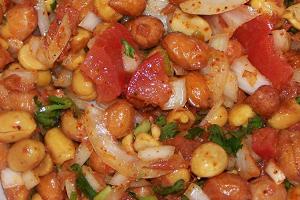The other day I was just thinking about the versatility of Indian cooking and the variety of food items it is offering. Far east countries, China or certain Latin American countries might have the concept of ‘make-food-out-of-anything’ but only Indian food promises so much of varieties and most importantly the usage of hundreds of spices.
Vegetarianism
India is a country that has got six or seven major religions. The vegetarianism (if not veganism) was mainly influenced by Hinduism. Also geographically speaking, one will find that North Indian food style is majorly vegetarian in nature. The percentage of population having non-vegetarian food is much more in South India – keralites being extremists in this case who do not mind having all kinds of meats and seafood.
Broad categorization
Though there are various sub-categories, one can broadly categorize the food style in India into two – North Indian style and South Indian style. North Indians prefer more bread items (wheat based and mostly grilled/toasted) and thick gravied rich curries mainly based on dairy products such as cottage cheese, yoghurt and milk cream. In the south the main food grain is rice and mostly rice along with some thin gravy curries make a meal. In both cases salads mean chopped onion or chillies and accompaniment mostly will include hot pickles. The traditional South Indian meal is served in plantain leaves where as the North Indian food is served in brass plates. In both cases it’s eaten with bare hands rather than spoons, forks, knives or chopsticks.
Influences
Though one might claim that Indian food style is quite unique and originated in India alone, you can see a lot of influenced or imported styles here. For example the Mughals brought in the kebabs and spiced rices culture to India where as the Chinese influenced stir-fried items such as gobi manchurion (cauliflower stir-fried and spiced) are more common in India than China itself. The British and Indian mixed (anglo-indian) styles became popular during the British rule and it is still common in parts of the country. The Portugese and the french gave us their own unique style which is still common in Goa and Pondicherry respectively.
Various Styles
There are hundreds of food styles and cuisines across the states and regions of India. Some of the prominent cuisines in the North include the Mughalai style, Parsi style, Punjabi style and the Gujarati style. Mughalai style is synonymous with biryanis or pulav that has dried fruits and nuts aplenty. Parsi style is a mix of western, Persian and Indian styles. Punjabi style is mainly tandoor (a large traditional oven) grill based where as Gujarati style basically include sweetened main courses and curries. In the South, Andhra style, Chettinadu style, Malabar style and Coorgy style are the major categorizations. Almost all these styles are rich in spices and chilli usage. All of them offer a wide variety of non-vegetarian delicacies as well. Apart from these, the western coastal Indian food style has a distinction of using coconut milk or paste in almost everything whereas coastal areas in general use seafood a lot. The Bengalies also eat a lot of fish but they prefer fresh-water fishes to seafood. Bengal and Orissa are also famous for mouthwatering sweets and desserts. The type of cooking oil used is another differentiator in Indian cooking. Most commonly used oils are sunflower oil, palm oil, mustard oil, groundnut oil, sesame oil, soybean oil and coconut Oil.
Good, bad, ugly
The Indian food offers variety. The right usage of spices results in good appetite and stimulation of the senses that results in overall health. However, overcooking of vegetables and meat is a common phenomena here that takes out the vitamins and natural taste out of food items. Another unhealthy part is the amount of oil used (that normally remains in the food and served) and the number of deep or shallow fried items. Despite all these it is really amazing how these hundreds of styles and thousands of delicacies co-exist in one big land. Yet another example of unity in diversity – Truly!
 Peanut Masala is more of a South Indian snack. Well, it is not exactly my favorite food but my vegetarian friends say that it is one of those few veg things that goes well with alcoholic drinks. And as a matter of fact, it does. It can also serve the purpose of an appetizer or starter at times.
Peanut Masala is more of a South Indian snack. Well, it is not exactly my favorite food but my vegetarian friends say that it is one of those few veg things that goes well with alcoholic drinks. And as a matter of fact, it does. It can also serve the purpose of an appetizer or starter at times.